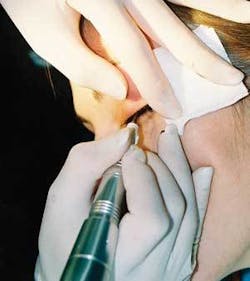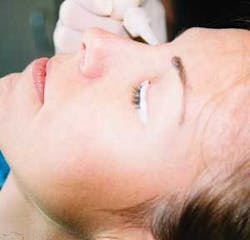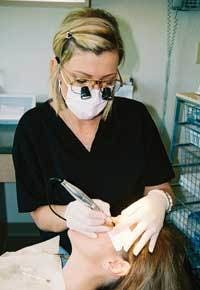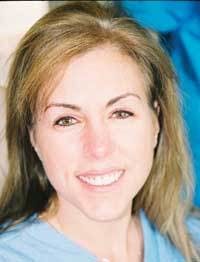Coloring Outside the Lines
Ifthis ad appeared in the Sunday paper, what occupations would fit the bill? Painter, dental hygienist, jeweler, tattoo artist?
Does the dental hygiene treatment room always have to be used for dental hygiene procedures? Not according to Julie Gillispie, RDH, of Cache, Okla., who also has the credentials CMM after her name.
If you’ve never heard of a CMM, you’re not alone. The designation, found only in Oklahoma, stands for Certified Medical Micropigmentologist. If you’re still in the dark, Julie is licensed to apply permanent pigmentation, or what is more commonly called a tattoo. Before you envision a rough-and-tumble, pipe-smoking, swaggering Popeye the Sailor Man with tattoos covering his bulging biceps, picture a statuesque, smiling blond performing permanent pigmentation procedures in her dental office in Marlow, Okla.
Body art has been around for centuries. While it has come in and out of fashion in western cultures, it is deeply entrenched in other parts of the world as a sign of wealth or cosmetic enhancement.
Just prior to their wedding ceremony, women in India adorn their bodies with intricate temporary tattoos made from henna. For years men in the armed forces have woken up with a permanent reminder of their night on the town. Today, young and not-so-young adults adorn their bodies with an endless array of colorful butterflies, flowers, symbols, mementos, and expressions of endearment.
In Nov. 2006, tattoo parlors will be legal for the first time in Oklahoma. However, CMMs will be the only ones legally allowed to perform specialized tattooing procedures, known as permanent makeup, in the Sooner State. Julie’s company is called Permanent Cosmetic Enhancements. However, if you want to have something tattooed on your ear or neck, Julie will not do it.
Five years ago, the Oklahoma Board of Dentistry ruled that dental hygienists could become CMMs and apply permanent pigmentation in the head and neck area. Therefore, Julie’s focus is on permanent makeup, which is applying permanent color to a client’s skin using a tattooing technique. Julie adds color to lips, recreates or enhances eyebrows, and applies eyeliner on the outer edge of the lower lid.
If you are blessed with great eyebrows or a lovely natural lip color, then permanent enhancement might seem farfetched. But if you draw your eyebrows in every day, or lost your facial hair due to an illness, then an afternoon with Julie might be just the ticket to restoring self-esteem.
Julie’s employer, Dr. Bruce Scott, is a former member of the Oklahoma State Board of Dental Examiners and an avid supporter of people reaching their full potential. His influence has encouraged Julie to become politically savvy and stay abreast of changes in the statutes that involve dental hygiene. So when she read about dental hygienists being able to perform permanent pigmentation procedures within a traditional dental office setting, Julie was intrigued with the possibility of expanding her clinical horizons in a very nontraditional way.
Dr. Scott encourages everyone on his staff to provide the most comprehensive patient care possible. One of his assistants is a Registered Massage Therapist who provides treatment for patients who suffer from TMD. Given his openness to new ideas, Julie approached Dr. Scott about becoming a CMM. He embraced Julie’s vision to provide the services to people in their community.
Julie began the arduous journey of acquiring her CMM, a field originally dominated by registered nurses. After a day of clinical dental hygiene practice, Julie attended classes twice a week from 6 to 9 p.m.
After she completed the didactic portion of her training at the Moore-Norman Technology Center, she had to pass a detailed written exam, then she was eligible to train under a licensed CMM. During this phase, Julie had to complete a dozen each of three procedures: full lip, eyeliner, and eyebrows. This part of her education had a big price tag because Julie had to hire a supervising CMM to be present during the 36 procedures. While it was difficult to find someone willing to take this on, and the hourly rate for supervision was quite high, Julie persisted.
According to Julie, dental hygienists are naturals for this new profession. We know how to work carefully in the head and neck area. We have good communication skills, we’re used to working in small areas such as the mouth, and we’re proficient with detailed procedures.
In addition, we’re used to working in someone’s personal space, can handle tense patients, and are tuned in to people’s body language. Another advantage is our understanding of the healing process, and our appreciation for the whole-body model of health and disease.
“Non-health-care CMMs do not have our medical knowledge, nor do they know how to answer medically related questions with depth and background,” Julie said.
She feels that those in health care have a higher compassion level than CMMs who hold a license outside of health care, such as in cosmetology.
Patient screening and preprocedural protocols are an important part of the process. Julie’s careful screening procedures rule out potentially troublesome or compromising situations. She will not perform procedures on medically challenged people because of possible healing complications. Julie uses her “dental hygiene sixth sense” to weed out candidates she feels will never be happy with the results of permanent makeup procedures.
She also draws the line at any crazy stuff. Her enhancement procedures are designed to help clients look natural, not garish. She also will not perform the procedure onchildren or teenagers unless there is a unique need, such as eyebrows for a burn victim. Parental permission is required before Julie will perform any procedure on a minor.
Physicians must release their patients for the procedure, and patients are advised to discontinue any blood thinner medications or aspirin five days prior to the procedure. In addition, clients scheduled for lip procedures must take 800 mg of Zovirax five days before and after the procedure to reduce the likelihood of an outbreak of a procedure-induced herpetic lesion.
Clients must understand that permanent cosmetic enhancement procedures are permanent. While it is possible to remove some types of tattoos with a laser, changes to the lips or around the eyes cannot be reversed.
You are probably full of questions about this unique career blend. Last year I spent the afternoon with Julie and saw firsthand how she performs her magic. All afternoon I peppered her with questions about her unique, parallel career.
Julie’s favorite procedure is eyebrow enhancement. According to Gillispie, women between the ages of 35 and 65 who have drawn in their brows every day for years are the most satisfied and grateful clients. They come in feeling vulnerable, and leave with a level of confidence that is priceless.
According to Julie, the procedures do not hurt. Lip and eyebrows require injectible anesthetic, a legal procedure for Oklahoma hygienists. The eyeliner procedure is annoying, but the application of a specially formulated topical anesthetic minimizes the discomfort. Once the topical anesthetic numbs the unbroken skin under the eye, Julie creates a small line of micro breaks in the skin surface with her hand-held tattooing device. This allows the second round of epinephrine-containing topical anesthetic to produce more profound anesthesia to reduce the discomfort of the eyeliner tattoo.
Julie’s post-treatment protocol is designed to maximize the success of cosmetic-enhancement procedures. All clients are advised to use sun block or apply ointments, depending on which procedure they have.
Clients request that the results be natural looking, and creating this natural look requires an in-depth understanding of color. For example, Julie will mix more red into the pigmentation for a client with olive-toned skin to avoid an unsightly purple tinge. She adds orange to any lip color to cancel out the natural blue undertones found in most people’s lips.
Burn victims present unique challenges for two reasons. First, they must undergo special preparations to prepare their skin to accept pigments, and second, they need color testing to determine how the shade will look under healed skin.
Personality, temperament, face shape, lifestyle, and age all play roles in creating a natural look. Some clients may need an additional appointment to touch up an area or deepen a color.
Dr. Scott provides Julie with all of the necessary supplies. The office books permanent cosmetic procedures on Thursdays or Fridays. Charges are based on time, and Julie’s compensation is based on a percentage of that fee.
Full lip, eyebrows, or eyeliner procedures each take about 90 minutes and range from $350 to $450, depending on the procedure’s complexity. Clients who want all three procedures book four-hour blocks for the full-face cosmetic enhancement. There is typically no insurance coverage for these procedures, which are considered cosmetic. In some cases, reimbursement is available for post-treatment cancer or burn survivors.
Typical of all emerging professions, the details provide an interesting look at how a profession began, is governed, and licensed. A CMM license is granted by the Oklahoma Medical Board. The examination is a two-part process, and the only acceptable grade for the written exam is 100 percent. The clinical exam is administered and graded by a physician.
Julie has not looked back since she became a licensed certified medical micropigmentologist. Her permanent makeup schedule fills up weeks in advance. She has found a way to make a difference - creating beauty with a tattoo gun. She is an artist with a different type of palette who shapes emotional wellness with every little stroke.
Author’s note: At the time of this publication, Julie is taking a break from her professional activities. She and her husband, Matt, are enjoying their son, James Dunn, born in mid-August.
Anne Nugent Guignon, RDH, MPH, is an international speaker who has published numerous articles and authored several textbook chapters. Her popular programs include ergonomics, patient comfort, burnout, and advanced diagnostics and therapeutics. Recipient of the 2004 Mentor of the Year Award, Anne is an ADHA member and has practiced clinical dental hygiene in Houston, Texas, since 1971. You can reach her at [email protected] or (713) 974-4540, and her Web site is www.anneguignon.com.





